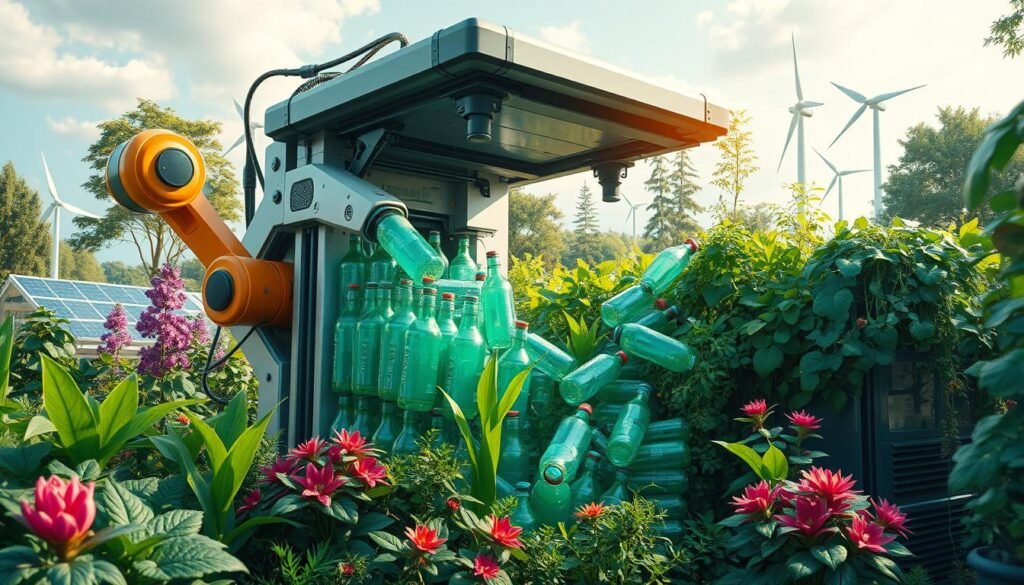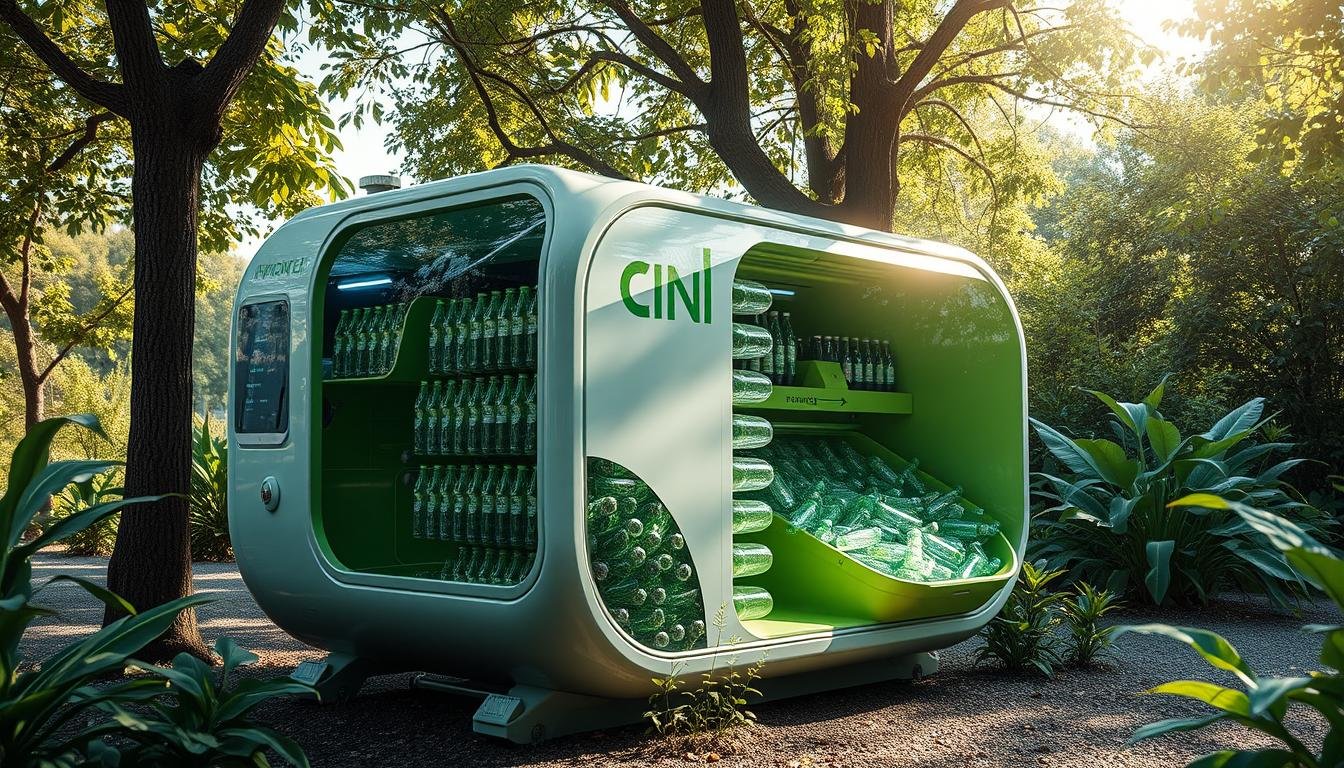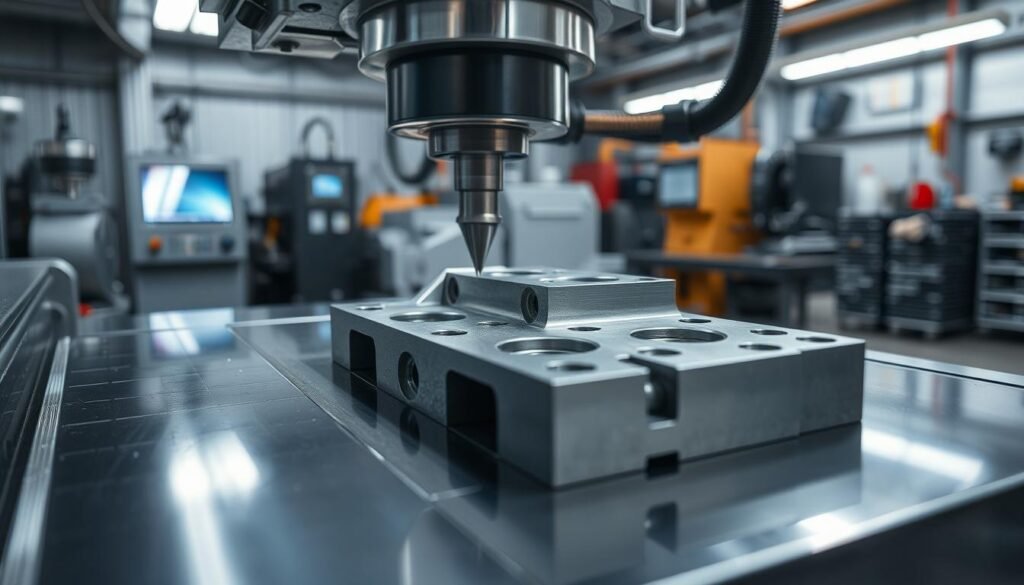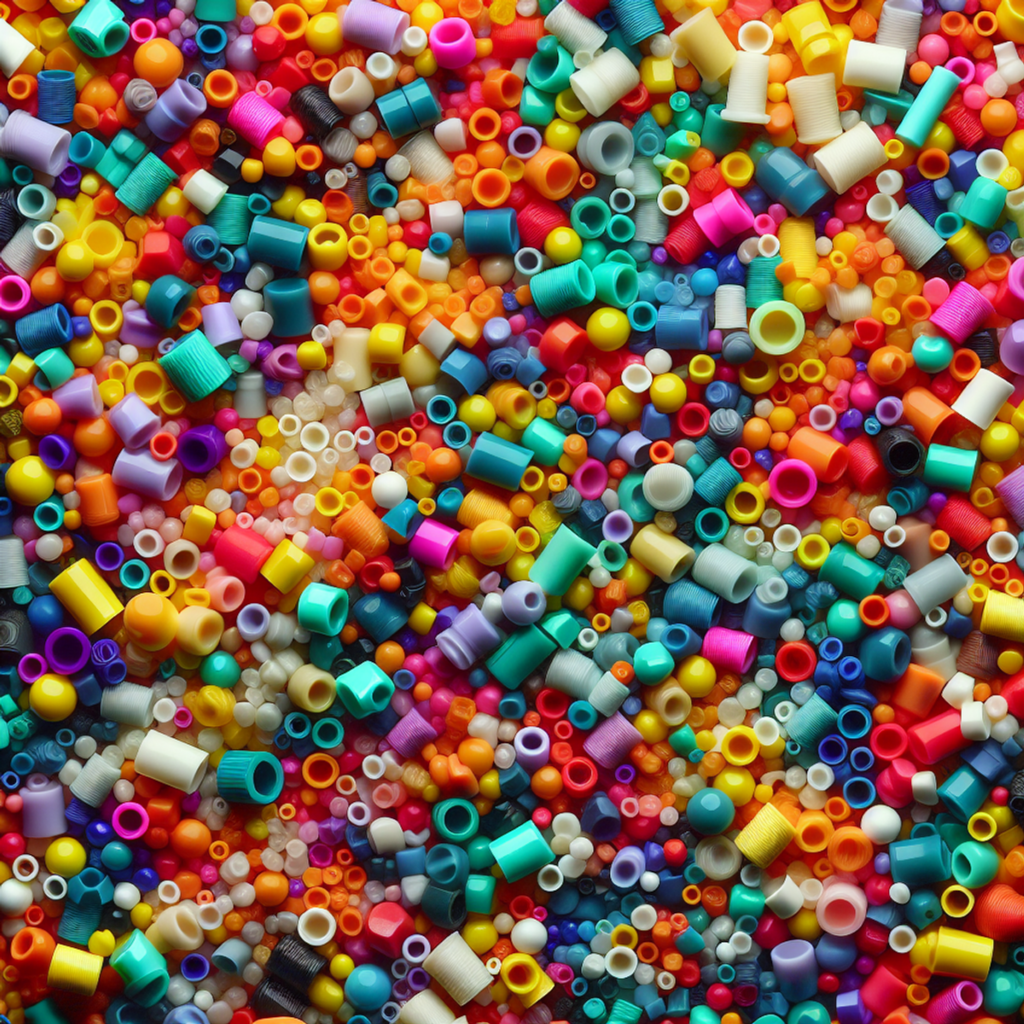Every year, a massive 1.4 trillion beverage containers become waste worldwide. This shocking fact alerts us to both a major environmental issue and a big chance for change. TOMRA Collection has taken this challenge head-on. It has created cutting-edge reverse vending technology. This technology is changing how we recycle beverage containers. With about 85,000 machines worldwide, TOMRA helps recycle over 46 billion containers every year. This is pushing us towards a world where we reuse everything and prevent pollution.
TOMRA has a noble goal: to greatly improve recycling so that up to 98% of beverage containers are recycled. They aim for sustainability and plan to reach net-zero greenhouse gas emissions by 2050. TOMRA’s machines are more than just equipment; they are a promise to our earth. They support the idea of using our resources wisely and keeping our planet healthy.
Key Takeaways
- Eco-friendly recycling is pivotal for handling the 1.4 trillion beverage containers used annually worldwide.
- TOMRA’s reverse vending technology and automated recycling systems are instrumental in combating plastic pollution.
- With a 98% return rate on eligible containers, TOMRA’s machines exemplify a high-efficiency circular economy.
- Capturing over 46 billion used beverage containers per year, TOMRA’s solutions underline a scalable impact.
- TOMRA’s long-term commitment to achieving net-zero greenhouse gas emissions by 2050 reflects environmental stewardship.
- Innovations such as EcoVend 1450x, which accepts up to 3-liter containers, demonstrate the versatility of reverse vending machines.
- Globally, reverse vending machines are fostering a surge in recycling rates and reducing environmental waste.
Understanding the Plastic Pollution Crisis
The escalation of plastic pollution is a major challenge we face today. Starting with 2.3 million tons in 1950, plastic production jumped to 448 million tons by 2015. Experts predict this number will double by 2050. Every year, about 8 million tons of plastic waste end up in our oceans, harming both marine and land ecosystems.
Conservation efforts aim to reverse these negative effects through sustainable waste management. In just the last 15 years, half of all plastics were produced. This makes the search for resource-efficient solutions more urgent.
Plastic pollution significantly harms wildlife. Nearly 700 species, including endangered ones, suffer due to entanglement or ingestion of plastic. Plus, plastics can take over 400 years to break down. They add dangerous chemicals to the environment, and microplastics are found everywhere, from Mount Everest to the Mariana Trench. These tiny plastics harm animals’ livers and reproductive systems.
An effective fight against plastic pollution requires a combined effort. We need better product designs, higher recycling rates, and less single-use plastics. Shockingly, only 15% of plastic waste worldwide is recycled. And over 30% of global citizens lack proper waste management, worsening the pollution problem.
Technology plays a key role in solving this issue, like plastic bottle recycling machines. These machines help turn old plastics back into reusable materials. They also teach people the importance of recycling, pushing us towards a circular economy.
| Focus Area | Strategic Action |
|---|---|
| Product Design | Develop biodegradable alternatives and redesign for durability |
| Waste Management | Expand access to recycling facilities, enhance sorting and processing capabilities |
| Consumer Engagement | Educate public, incentivize recycling through policies and practical solutions |
| Legislative Support | Implement stricter regulations on plastic production and waste management |
To truly minimize plastic pollution, everyone needs to contribute. From government officials to everyday people, and from manufacturers to environmentalists. Our goal is to preserve our natural surroundings and ensure a green future. Every step toward sustainable waste management and resource-efficient methods matters. It’s all about protecting our planet for those who come after us.
Introducing the Plastic Bottle Recycling Machine
Innovative technology like reverse vending machines has transformed plastic recycling. These machines are vital for effective deposit return systems worldwide. They not only make container collection automatic but also boost recycling efforts.
What Is a Plastic Bottle Recycling Machine?
A plastic bottle recycling machine automates the collection, sorting, and recycling of plastic bottles. At its core are reverse vending machines (RVMs) that streamline container collection. Thanks to RVM technology, these machines achieve high recycling rates. They ensure that plastic bottles are reused, keeping them out of the environment.
Types of Plastic Bottle Recycling Machines
Plastic bottle recycling machines vary in models, each serving different needs. Take the Model WM-YC106; it processes plastic bottles, aluminum, and steel cans. This model features a 17-inch touchscreen for easy interaction. Then there’s the YC-301 model, perfect for big operations. It can hold 400 plastic 0.5L bottles or 800 0.33L cans.
The Role of Reverse Vending Machines in Recycling
Reverse vending machines play a vital role in deposit return systems. They make recycling both easy and rewarding. Thanks to RVMs, billions of containers are collected each year worldwide. Beyond helping the planet, these machines offer perks. They give rewards like tickets or QR codes, encouraging people to recycle more.
Modern RVMs come with advanced features. For instance, they have barcode systems that sort containers quickly and accurately. This boosts the recycling process’s speed and precision.
| Feature | Description |
|---|---|
| Machine Model | WM-YC106 |
| Accepted Materials | Plastic bottles, aluminum, steel cans |
| Capacity | 400 plastic bottles or 1000 cans |
| Display Type | 17-inch touchscreen |
| Connectivity | WIFI/3G/LAN support |
| Barcode Reading Speed | Up to 30 containers per minute |
| Rewards System | Dual thermal printer for coupons, multiple customized reward options |
Eco-Friendly Benefits of Bottle Recycling Technology
Environmental sustainability is more crucial than ever. With Reverse Vending Machines (RVMs), recycling technology sees major eco-friendly benefits. These machines boost recycling incentives and aid in significant waste reduction. They help achieve bigger environmental sustainability goals.

Small plastic recycling machines, especially RVMs, are key in processing different plastic wastes. This includes bottles and packaging. They fit well in communal areas, making recycling easy and accessible. By giving rewards like cash or coupons, RVMs motivate people to recycle more.
“Investing in RVM technology not only supports a sustainable business model but significantly contributes to the global effort in waste reduction.”
These machines are designed for scalability and efficiency. They handle various plastics like PET, HDPE, and PVC. This turns potential waste into valuable recycled materials. Here’s a look at different small recycling machines and what they can do. It shows the versatility and efficiency of this technology:
| Type of Machine | Material Processed | Output Per Hour |
|---|---|---|
| Small Plastic Shredder | PET, HDPE, PVC | Up to 50 kg |
| Plastic Granulator | PET, HDPE | 40 to 70 kg |
| Plastic Pelletizing Machine | Various Plastics | 30 to 60 kg |
| Air-cooled Recyclers | LDPE, HDPE | 40 to 50 kg |
This progress in recycling helps the environment and opens economic doors. RVMs create jobs like machine servicing and material processing. This boosts local economies.
- Enhanced quality of recycled materials due to advanced sorting and processing.
- Reduction in environmental degradation by diverting waste from landfills.
- Promotion of a culture of recycling through user incentives.
Integrating this cutting-edge machinery into daily lives drives sustainability. This matches environmental aims with economic benefits.
How Does a Plastic Bottle Recycling Machine Work?
To grasp the full recycling process using reverse vending machines, let’s look at their key steps. These machines promote sustainable behavior in people. They also make sorting recyclables easier and faster.
The Process of Collecting, Sorting, and Processing
First, reverse vending machines collect used beverage bottles and cans. When someone puts a container in, advanced recognition technology checks its type and condition. This step ensures only recyclable items are accepted, cutting down on waste.
Then, the machine sorts the items based on material—whether plastic, glass, or metal. This step boosts recycling process efficiency. Lastly, it compacts the items to cut down on space. This makes it easier to ship them off for recycling.
Advanced Technologies Behind the Machines
The heart of a plastic bottle recycling machine lies in its cutting-edge tech. Equipped with swift sensors and AI scanners, these machines quickly process bottles and cans. They can sort each one in under 40 milliseconds. With this advanced recognition technology, recycling becomes more precise and effective.
Incentivizing Consumers to Recycle
Incentives are key to getting people to recycle more. Reverse vending machines give money back or vouchers. This acts as a consumer incentive for doing the right thing. It encourages everyone to recycle more often. It also helps make living green a part of everyday life. This supports bigger goals for our planet.
Learn more about the groundbreaking reverse vending machines that streamline the recycling process, making it simpler and friendlier for everyone involved.
| Feature | Details | Impact on Recycling |
|---|---|---|
| Technology | Advanced sensors, AI recognition | High-speed, accurate processing |
| Consumer Incentives | Monetary refunds, vouchers | Encourages continuous consumer participation |
| Sorting Capability | Automatic segregation by material type | Prevents contamination, improves recycling quality |
| Accessibility | Located in public spaces like malls and parks | Makes recycling convenient and accessible |
The Impact of Reverse Vending Machines on the Environment
Reverse vending machines (RVMs) are key in bettering our planet and boosting waste diversion. They make recycling easy and rewarding, helping save resources and improving recycling streams.
RVMs have greatly improved how well and how clean we recycle. They reduce landfill waste and make sure recycled goods can be reused. By using RVMs, we move closer to a circular economy and cut down the environmental harm from plastic.
| Statistic | Details |
|---|---|
| Recycling Rate Increase | Recycling rates increased by an average of 51% according to the Beverage Industry Environmental Roundtable (BIER). |
| Energy Savings | Smart RVMs save up to 90% of the energy needed for recycling according to reports. |
| Collection Rate Improvement | Deposit return systems, aided by RVMs, boast an impressive collection rate of up to 98% for eligible drink containers, significantly reducing beverage container litter by 66%. |
| User Motivation | Surveys indicate that 74% of respondents in the EU are more likely to recycle when incentives are involved, with statistics reaching an 80% increase in willingness to recycle due to the usage of RVMs. |
| Global Installations | TOMRA, a leading provider, operates 80,000 reverse vending installations across more than 60 markets globally. |
RVMs have proven to bring major environmental gains by reducing waste and saving energy. They improve the quality of recycled materials. This makes recycling more efficient and effective. These machines play a crucial role in achieving global sustainability and protecting our environment.
Personal and Commercial Advantages of Plastic Bottle Recycling
Recycling plastic bottles, especially through Reverse Vending Machines (RVMs), brings many perks. It includes economic benefits, cost-efficiency, and better public perception. This powerful mix boosts environmental care and helps businesses run both profitably and responsibly.
Cost Savings and Economic Incentives
RVMs make recycling an activity that pays off economically. Businesses cut down on waste disposal costs and make money from recycled stuff. Meanwhile, folks get rewards like discounts or store credits for recycling. This encourages them to keep recycling. For example, stores such as Morrisons and Tesco give points for using RVMs. This helps both the environment and the economy. The money spent on RVMs tends to pay off in 2 to 5 years, proving they’re cost-effective.
Improving Public Perception with Sustainable Practices
Adding RVMs can make a brand look better. It shows a company cares about the environment, meeting customer expectations. Seeing RVMs at stores or public areas builds trust in the business. For instance, Canary Wharf’s RVMs, part of its ‘Breaking The Plastic Habit’ campaign, not only help recycle but also boost public perception of the area as environmentally responsible.
Case Studies: Success Stories from Retailers and Communities
Sustainability case studies worldwide show RVMs’s positive role in business and community spheres. For example, Germany hit a 98% return rate, and Russia saw great results from public-private partnerships. These stories show how RVMs help the environment and improve recycling habits among people.
| Country | Return Rate (%) | Public/Private Collaboration |
|---|---|---|
| Germany | 98 | Extensive |
| Denmark | 92 | High |
| Norway | N/A | Significant (3,700+ RVMs) |
| United Kingdom | N/A | Expanding (Tesco and more) |
The Role of Policy in Advancing Bottle Recycling Efforts
Deposit return systems are key for better recycling in the U.S. They help create a circular economy. Companies like TOMRA offer frameworks that show how important these systems are. They help reduce plastic pollution.
For better recycling, policymakers need to understand how recycling policy affects both the community and the environment. Deposit return systems encourage people to recycle. They increase the rates at which plastic bottles and cans are recycled.
Introducing these systems has improved recycling rates in many states. They make recycling easier and more efficient. By using deposit return systems, cities can meet and even surpass recycling goals. This supports the aim of a circular economy.
Here are some key facts that show the impact of good recycling policy:
| Policy | Impact on Recycling Rate | Material Value Recapture |
|---|---|---|
| EPR Policies in the U.S. | Up to 75% increase | $13M to $91M |
| International EPR Programs | Over 75% collection and recycling | N/A |
| Colorado’s New EPR Law | Up to 48% increase | Significant Job Creation |
The role of policy in promoting recycling is crucial. Data shows that strong policies and resources for policymakers increase recycling rates. They also provide economic and environmental benefits. This is essential for achieving sustainability and supporting a thriving circular economy.
Sustainable Solutions: From Plastic Bottle Recycling Machine to Recycled Products
Plastic bottles go from trash to treasure through advanced recycling. These innovations help recycled materials last longer. They also make a strong recycling market. Machines like reverse vending ones help solve recycling problems. They bring big benefits for the environment, too.
The Lifecycle of a Recycled Plastic Bottle
A recycled plastic bottle has an exciting journey to becoming something new. It starts when people put bottles into reverse vending machines. These encourage everyone to recycle more. The machines sort the bottles by type, color, and size.
Next, the bottles get cleaned and chopped into flakes. They’re melted down and turned into pellets. These pellets become the start of new products. This closes the loop, making recycling a circle of sustainability.
The Market for Post-Consumer Recycled Materials
More people want recycled materials now, thanks to growing eco-awareness. Companies like Unilever have cut down on new plastic use. This helps the recycling market grow. The Waste-Free World project shows how big teams can make a difference in recycling. Unilever and Alibaba are teaming up for better recycling practices.
Challenges and Opportunities in the Recycling Industry
The recycling world faces some hurdles like material contamination and economic issues. Regulations across areas differ, too. But, there are chances for progress with new tech and laws that support recycling. Tech like AI in sorting and digital projects like Ant Forest can have a real environmental impact.
| Year | Number of Machines | Total PET Bottles Collected (Tons) |
|---|---|---|
| 2018 | 759 | 8,900 |
| 2022 | 3,174 | 12,400 |
Overcoming recycling industry challenges requires ongoing tech and innovation. Each recycled bottle pushes us toward a greener future. It shows how we all play a part in recycling’s success.
Global Innovations in Plastic Bottle Recycling
The world of global recycling innovations is changing fast, thanks to new technology in plastic bottle recycling. We’re seeing amazing things like artificial intelligence used in sorting systems. And there are new ways to turn waste into valuable products. These changes are making recycling more effective worldwide.

Optical and NIR sorting technologies are improving how plastics are processed. They make it faster and increase the quality of recycled plastics. This lets us sort different kinds of plastics better, preparing them well for recycling.
Some places are using new methods like pyrolysis and chemical recycling for hard-to-recycle plastics. These break plastics down to their basics, letting us make new, quality materials. It’s a boost for sustainable recycling and meets demand for better recycled products.
Comprehensive plastic recycling efforts by cities and countries are upping recycling rates and cutting plastic waste in landfills.
Artificial intelligence and machine learning are getting into recycling, too. They help improve sorting by analyzing and classifying plastic waste swiftly. This leads to more accurate sorting and better recycling.
There’s also an exciting trend of making plastic roads and urban furniture from recycled plastics through 3D printing. This shows how recycled materials can be both creative and functional. It helps the environment and supports a circular economy.
New technologies are being developed to tackle marine plastic pollution. They aim to clean plastics from oceans and water bodies, protecting marine ecosystems. It’s a step forward in fighting plastic pollution in our waters.
Overall, these technological advances are promising for making plastic recycling more sustainable, efficient, and viable economically. Considering the worrying prediction that plastics might outnumber fish in the oceans by 2050, the role of these innovations is crucial. They’re key to promoting more effective and sustainable recycling practices.
Conclusion
Recycling technology has grown a lot in the United States. It’s making a big difference for our planet’s future. We see a real drop in how much plastic waste ends up in landfills and oceans. This success comes from better recycling machines.
This progress cuts down pollution. It shows we’re getting serious about taking care of the environment. People and businesses are changing how they act to be more eco-friendly.
Recycling machines, like compactors and shredders, are key in saving resources and reducing our carbon footprint. They help make less CO2 and need less energy. This makes recycling an important part of being more eco-friendly. Companies like EnvCure are investing in new machines. They make recycling things like PET bottles good for both the planet and business.
The future looks bright with the ongoing improvement of recycling machines. Making sure these machines work well is crucial. And, we need to keep promoting recycling habits. Different plastics need different recycling methods. This helps keep our recycling efforts strong.
Experts are hopeful about the future of recycling. As machines get better, their positive impact on our planet increases. Recycling advancements show us the way to a greener tomorrow. Our efforts now are building a better future.
FAQ
What are the eco-friendly benefits of using a plastic bottle recycling machine?
Using a plastic bottle recycling machine helps lower plastic pollution. It helps save resources by recycling. It also reduces greenhouse gas emissions by cutting down on new container production. This supports a circular economy.
How do reverse vending machines contribute to sustainable waste management?
Reverse vending machines make collecting and sorting beverage containers easy. They help recycle more, improving material quality. They also lower the amount of waste going to landfills.
What incentives do consumers receive for using plastic bottle recycling machines?
Consumers get money back or vouchers for recycling. This encourages them to keep recycling. It helps in keeping our environment clean.
Can you explain the role of advanced recognition technology in the recycling process?
Advanced technology helps identify and sort recyclables accurately. It uses sensors and AI to check materials. This ensures they’re right for recycling and reduces wrong materials.
What is the environmental impact of reverse vending machines?
These machines help recycle more, lowering waste in landfills and oceans. They help keep recycling clean. This protects our natural resources from plastic damage.
What are the commercial advantages of implementing a plastic bottle recycling machine?
Businesses save money on waste management by recycling. They earn from recycled materials. This also boosts their image for using sustainable practices. It can attract new customers, too.
How can policymakers support the advancement of bottle recycling efforts?
Policymakers can help by regulating deposit return programs. They can also provide tech resources for communities. Making policies that support recycling and a circular economy is key.
What is the lifecycle of a recycled plastic bottle?
The process starts with collection and sorting of bottles. Then, they are cleaned, shredded, melted, and turned into pellets. These pellets are used for making new products. This creates demand for recycled materials.
What challenges and opportunities exist within the recycling industry?
Recycling faces issues like material contamination and the need for better tech. However, there’s a chance to innovate. Creating markets for recycled products is another opportunity. This can improve how we use recycled materials.
In what ways is the international community innovating with plastic bottle recycling?
The world is improving reverse vending machines and collection systems. There’s a focus on eco-friendly recycling methods. Technology is also being used for better communication and advertising in multiple languages.






